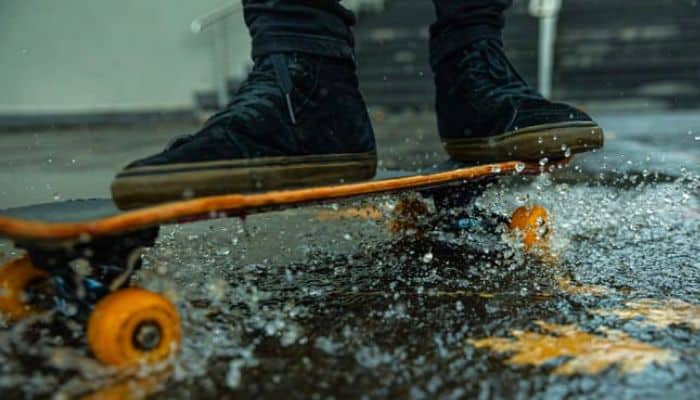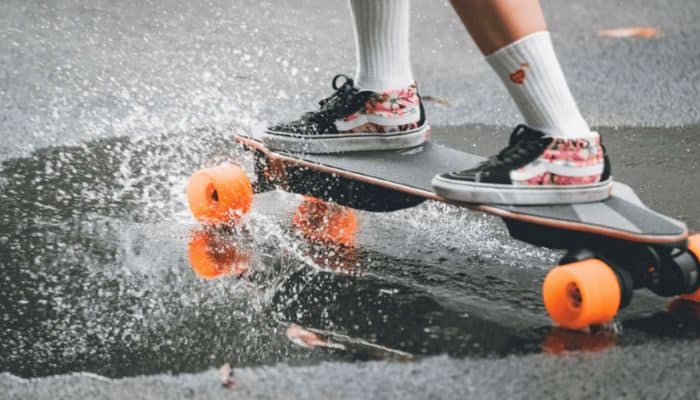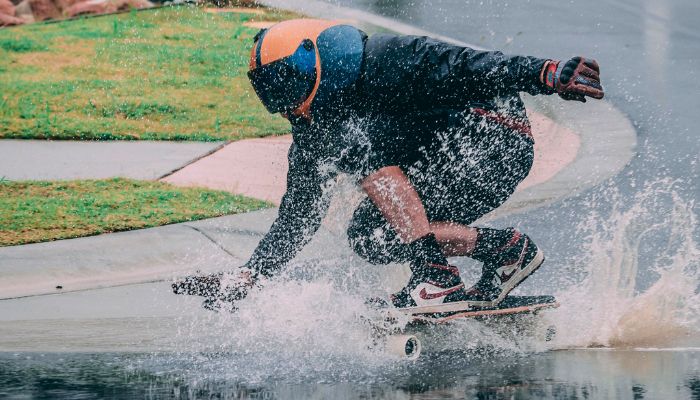Electric skateboarding offers a thrilling blend of convenience and fun, but like any electronic device, it comes with its limitations, particularly when it comes to weather conditions. One common question many riders have is: Can you ride an electric skateboard in the rain? This query is crucial not only for maintaining the longevity of your board but also for ensuring your safety. In this first part of our series, we delve into the risks and considerations associated with riding an electric skateboard in wet conditions.
Understanding the Risks
1. Water Damage to Electrical Components
The most significant risk of riding an electric skateboard in the rain is water damage. Electric skateboards contain critical electrical components, including the motor, battery, and control systems. While many manufacturers now design skateboards with some degree of water resistance, few are fully waterproof. Water can seep into the motor bearings, battery box, and electrical circuits, potentially leading to corrosion, short circuits, and ultimately, failure of these components.
2. Reduced Traction on Wet Surfaces
Wet surfaces significantly reduce traction, making it harder to control the skateboard. The wheels of electric skateboards are typically made for dry conditions, and when used on wet or slippery surfaces, the risk of accidents increases. This loss of traction can affect braking and turning, making it dangerous to ride in the rain.
3. Increased Wear and Tear
Riding on wet and dirty surfaces accelerates the wear and tear on your skateboard. Moisture can cause the metal parts of your skateboard, such as screws and bearings, to rust. Additionally, dirt and debris carried by rainwater can clog the mechanical parts of your board, necessitating more frequent maintenance and potentially costly repairs.
Precautions and Waterproofing Solutions
If you find yourself needing to ride in damp conditions or light rain, there are several precautions you can take to minimize risks and protect your board:
1. Check for Water Resistance Ratings
Before riding in any amount of water, check your electric skateboard’s specifications for water resistance. Look for IP ratings (Ingress Protection) that indicate how well the board is protected against the entry of solid and liquid matter. Boards with higher IP ratings have better protection against water, though this does not mean they are suitable for riding in heavy rain.
2. Use Conformal Coating
For those who are technically inclined, applying a conformal coating to the internal components of your skateboard can provide an additional layer of protection against moisture. This coating helps to shield the electronics from water damage but should be applied with care to avoid covering heat vents or connectors that require exposure to air.
3. Seal Exposed Areas
Pay attention to areas like the charging port and power button, which are common entry points for water. Ensure these are adequately sealed or covered when riding in wet conditions. Some skateboard models come with covers for these parts, but you can also use waterproof tape as a temporary solution.

When to Avoid Riding
Despite all precautions, there are conditions under which you should avoid riding your electric skateboard altogether:
- During Heavy Rain: If the weather forecast predicts heavy rain, it’s best to leave your electric skateboard at home. The risks to both your safety and the integrity of your board increase significantly under such conditions.
- On Puddles and Standing Water: Riding through puddles or standing water can quickly lead to water ingress and should be avoided. Even boards labeled as water-resistant can succumb to the pressures of accumulated water.
- Post-Rain Conditions: Be wary of riding immediately after a rainstorm, as the ground may still be wet and slippery, and hidden puddles can surprise you.
Safety Tips for Riding in Wet Conditions
When riding an electric skateboard in the rain is unavoidable, prioritizing your safety is paramount. Here are essential safety tips to consider:
1. Lower Your Speed
High speeds on wet surfaces increase the likelihood of accidents. Slow down to maintain better control of your board, which will allow you more time to react to slippery surfaces, unexpected puddles, and other hazards.
2. Avoid Sharp Turns
Sharp turns on wet surfaces can lead to slipping and falls. Make gentle and wide turns to ensure the wheels maintain contact with the ground and provide better traction.
3. Wear Appropriate Gear
In addition to the regular safety gear like helmets and pads, consider wearing water-resistant clothing to stay dry and maintain body temperature. Wet clothing can make you feel cold and uncomfortable, potentially distracting you from safe riding.
4. Use Lights and Reflective Materials
Reduced visibility is a significant hazard when riding in the rain. Use lights on your skateboard and wear reflective clothing to ensure you are visible to other road users.

Post-Rain Care for Your Electric Skateboard
Taking care of your electric skateboard after riding in the rain is crucial to prevent long-term damage. Here’s what you need to do:
1. Thorough Cleaning
After riding in the rain, clean your board thoroughly. Wipe down the deck, trucks, wheels, and bearings to remove any dirt, grime, and moisture. This prevents rust and corrosion from setting in and keeps your board in good working condition.
2. Check and Dry Electrical Components
Inspect all electrical components for moisture. If your board isn’t highly water-resistant, consider disassembling parts like the battery box and motor to ensure they are dry. Use a dry cloth to gently wipe down these components. Avoid using a hairdryer or other heat source as these can damage the electrical systems.
3. Lubricate Bearings
Water can wash away lubrication from the bearings, which can cause them to seize or corrode. After cleaning, re-lubricate the bearings to ensure they roll smoothly and are protected from moisture.
4. Store Properly
Once your board is clean and dry, store it in a dry, cool place away from direct sunlight. This helps prevent the deck from warping and the electronic components from deteriorating.
Long-Term Maintenance
Regular maintenance is key to keeping your electric skateboard in prime condition, especially if you frequently ride in wet conditions. Periodically check for signs of rust or wear and tear, especially on metal parts and connections. Replace any parts that appear damaged or degraded to ensure your board remains safe and reliable.
Conclusion
While you can ride an electric skateboard in the rain, it requires taking significant precautions to ensure safety and prevent damage to your board. Always consider the weather conditions and the capabilities of your skateboard before heading out. By following these safety and maintenance tips, you can enjoy riding your electric skateboard in various weather conditions while keeping it in optimal condition for years to come. Remember, safety always comes first, so when in doubt, it’s better to skip the ride and wait for clearer skies.

